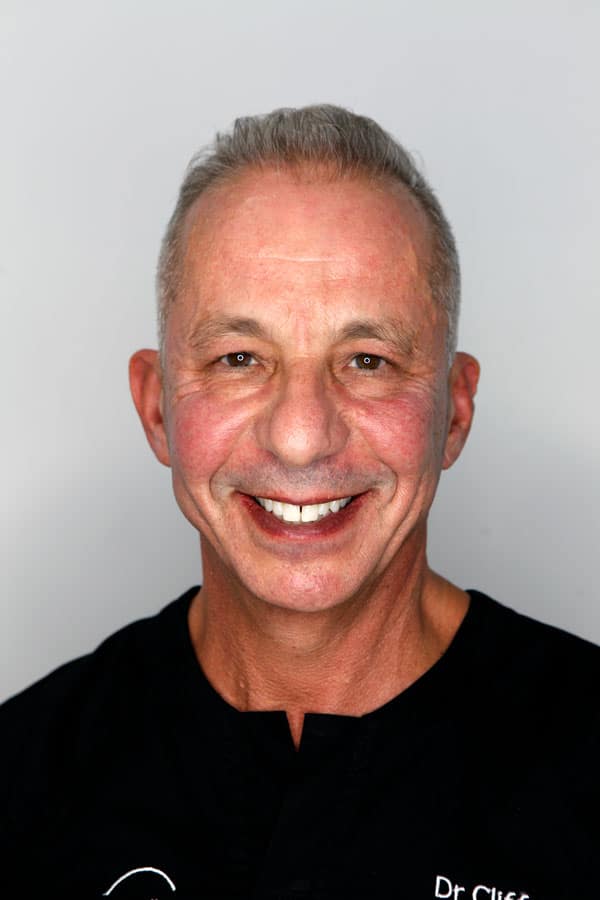Chapter 1: Introduction to Dental Fillings
[00:00:12-00:01:12]
Host Eon Engelbrecht introduces the podcast and guest Dr Clifford Yudelman, setting the stage for a detailed discussion on dental fillings.
Chapter 2: Understanding Dental Fillings
[00:01:13-00:03:15]
Dr Yudelman explains the purpose of fillings in Cape Town and the scenarios that require them, then begins discussing the various types of fillings available.
Chapter 3: Delving into Amalgam Fillings
[00:03:16-00:05:48]
An in-depth look at amalgam fillings, their history, pros and cons, and environmental considerations.
Chapter 4: The Cultural Aspect of Gold Fillings in South Africa
[00:05:49-00:07:52]
A discussion on the popularity and cultural significance of gold fillings in South Africa.
Chapter 5: The Role and Fashion of Dental Grills
[00:07:53-00:09:38]
Examination of dental grills as a fashion statement and their implications for dental health.
Chapter 6: The Filling Process Explained
[00:09:39-00:14:34]
Dr Yudelman outlines the step-by-step process of getting a dental filling, emphasising the importance of precision and care during the procedure.
Chapter 7: Additional Insights on Drilling and Filling Techniques
[00:14:35-00:17:15]
Further clarification on the drilling process and its critical role before placing a filling.
Chapter 8: Post-Filling Care and Advice
[00:17:16-00:21:03]
Advice on post-filling care, including dietary recommendations and the importance of immediate care after the procedure.
Chapter 9: Wrapping Up with Prevention Tips
[00:21:04-00:22:57]
Dr Yudelman concludes with prevention tips, highlighting the importance of proper dental care and hygiene in avoiding fillings.
[00:00:12] Eon Engelbrecht E-Radio-SA: Welcome to Save Your Money, Save Your Teeth, the go-to podcast where curiosity meets dentistry straight from the experts. I’m Eon, and every week I’ll be chatting with Doctor Clifford Yudelman, taking a deep dive into the world of dental care from a consumer’s perspective. So whether you’re looking to brighten that smile or protect your wallet, we’ve got you covered with practical advice and the latest insights. So stick around as we uncover the secrets to maintaining both your dental health and also your finances. Today we’re talking about fillings. Doctor Yudelman welcome back.
[00:00:52] Dr Clifford Yudelman OptiSmile: Hi Eon, It’s great to be back on the show. Thanks for having me back. And after all of our previous episodes about bad breath, the psychological aspects of a smile, and the economics of prevention, I thought today we’d get stuck in and talk about fillings. So what do you want to know?
[00:01:13] Eon Engelbrecht E-Radio-SA: Can you explain firstly to us what a filling is and why I would need it in my mouth?
[00:01:19] Dr Clifford Yudelman OptiSmile: So fillings are to repair or to restore the integrity of your tooth. Generally, if your tooth has a cavity, so that’s when you have decay on a tooth. Or we use fillings if someone has chipped or broken a tooth, maybe, maybe from a fall or an accident. And also, these days, we see a lot of erosion, and we do bonded fillings. But the fillings that we mainly speaking about today are your everyday type of filling, which is removing decay from a tooth and filling in the hole that’s left behind. We’ll talk about the types of fillings that we use these days and how a filling has been done. Should I just carry on with the types of fillings? Because a lot of people ask us, doc, is it going to be a white filling or one of those black fillings or so-called silver fillings? So all around the world these days, white fillings are way more popular. There are dentists in certain areas and depending on the type of practice you go to, that still do place silver amalgam in teeth. So when people think of fillings, we think mainly of the white ones, which are composite or tooth coloured and silver amalgam, which are the ones that eventually go black. There’s also ceramic fillings, which is your ceramic inlays and onlays, and then things like gold, which is hardly ever used uh, anymore, except in South Africa, sometimes on front teeth. And there are a few other types of fillings which we probably will leave out today. So it’s not too long today. Each of these types of fillings has its pros and cons. I think maybe we should start off talking a little bit about amalgam now that I’ve spoken about amalgam.
[00:03:16] Eon Engelbrecht E-Radio-SA: Yeah.
[00:03:17] Dr Clifford Yudelman OptiSmile: Okay, great. Yeah. So amalgam has been used for well over a century. The guy who invented it was the founding father of so-called modern dentistry. But I think that was 1.0, we’re now in a in an evolution and a revolution with digital dentistry and things that come a long way. And I was still doing silver fillings when I left the United States. I was practising in San Diego for 16 years, and I moved to Australia in 2002, and I was still placing silver fillings back in 2002, in back teeth, because I wasn’t so sure that white fillings had come, you know far along enough for them to be strong enough to use in back teeth. But around about 2002, I stopped using silver fillings completely. There are still dentists who use silver fillings, and silver fillings are very quick and simple to do. If you’re on a medical aid, a lot of medical aides will only cover a silver filling, uh, because they are cheap and and very quick. They’re not very difficult. You know, there’s a simplicity involved. There are some pros and cons of silver fillings these days. It’s mainly cons. We see old silver fillings causing cracks in teeth and also parts of teeth just breaking off when a filling gets old.
[00:04:44] Dr Clifford Yudelman OptiSmile: And, of course, there’s the aesthetics of the actual filling, and the whole tooth can go grey. I’m not one of these dentists who’s too overly concerned about the mercury in silver fillings. The mercury is locked into the filling. There are some concerns. In certain countries they have banned silver fillings because it contains mercury. But I don’t think it’s so much because of the mercury that the patient is getting from the filling. But when we place silver fillings, you know, we use a vacuum, a suction, and the mercury ends up in the ocean and it poisons the fish. A lot of people are concerned about mercury in their fillings but probably get a lot more mercury every time they eat sushi. If you eat tuna, big fish that eat little fish, there’s a lot more mercury in those. But that mercury might be coming from dental practices in the first place. So that’s a complex question. I mean, we’re lucky that we don’t get too many requests for silver fillings anymore, but they are still done.
[00:05:49] Eon Engelbrecht E-Radio-SA: Okay. And what’s the story here in South Africa with the gold fillings? We see that so often on front teeth. What can you tell me about this type of filling? Why is it so popular here in our country?
[00:06:02] Dr Clifford Yudelman OptiSmile: So we do get we do get requests. People say, do you do gold on the front tooth or silver on the front tooth? And it’s a cultural thing. I think people think it looks attractive. I don’t have any problem with people that stick a little gold star or a little gold heart, or a little diamante or something on a tooth, as long as the tooth is not damaged. But we do see people who get the gold put on their teeth where the dentist or back street dentist has gone and cut the tooth or drilled the tooth and then put a very inexpensive, I can assure you they’re not using gold, it’s some kind of brass or something. They’re doing it purely for financial gain. If any of those dentists are listening, you’re welcome to take out a court case against me. I don’t think any registered dentist with the South African Dental Association (SADA) would take a virgin tooth and put gold on a front tooth. And in fact, a lot of people that get that done tend to regret it then. I mean, I’m even don’t have a problem with someone wearing properly made grills. You know, you want to have flash or gold on your front teeth and maybe get a grill. I think a lot of grills might damage teeth. I haven’t seen a well-made one, but there are dentists in Johannesburg that specialize in them, and they’re cosmetic dentists, quite highly regarded. And I’m sure the grills that they make won’t damage teeth, but those gold slivers or whatever you want to call them, I would definitely warn people against them. Gold fillings. I’ve got a gold inlay or a gold crown on one of my back molars. It’s been there for 30 years. They do last a very long time, but that’s not the type of gold crown that we’re talking about here, is it?
[00:07:53] Eon Engelbrecht E-Radio-SA: So the grills. Why do we see these grills as well? What even is the purpose of the grills? Or is that just like a bit of a statement? I was just wondering about these grills that you see nowadays.
[00:08:05] Dr Clifford Yudelman OptiSmile: Yeah. So grills are removable? I don’t think too many people get grills permanently installed. I mean, if you did have something like that put over your teeth, you would definitely get gum disease and cavities in no time, and then you end up with no teeth at all. So the types of grills that I’m talking about is where, uh, if you if you’re going to have a grill made properly these days, you would use a digital scan and have a very accurate model of the teeth. And then, the grill is designed, in wax first or digitally printed. And then that gets cast by a jeweller, and they can put real diamonds and gold and all of that, and you wear it like when you go out, you put a bracelet and some rings on or a necklace like flashy, you know, I try and keep an open mind. I don’t want to judge, you know, one culture or one group of people’s idea of beauty might not match with our own. So I always try and keep an open mind. But for me, you know, the health of the mouth and the teeth comes first. If some rapper is getting a $1 million grill, you can be sure he’s not damaging his teeth, but someone might go somewhere in the back street and get a very cheap grill done or what they think is the same as what the rapper is getting and get completely ripped off. So since this is about “Save your Money, Save your Teeth, I think you can save both your money and your teeth by taking that advice.
[00:09:39] Eon Engelbrecht E-Radio-SA: Doctor Yudelman, let’s talk about the step-by-step process for dental fillings. I once had a filling done, and it looked like the dentist was busy with some kind of paste, and then this paste later went harder. Is that correct, or how does it work?
[00:09:54] Dr Clifford Yudelman OptiSmile: Yes, yes. Yeah. So if we’re talking now about where you’ve got a cavity between your teeth or in the groove in the top of the tooth and not a replacement filling if it’s a first-time tooth is getting a filling. Normally, the dentist will take those little X-rays to look between your teeth, or dry your teeth and look with a magnifying loupe or with a microscope, or you can see it in a photo. So, the first step in the process of getting a filling is to make sure that the tooth actually needs a filling in the first place. So there’s sometimes can be small cavities starting between teeth. And they don’t always need a filling. The filling can be reversed, or the cavity can be reversed by flossing. Not not, uh, drinking acidic, uh, drinks and, and, you know, basically giving up Coca Cola and other soft drinks and using a fluoride toothpaste. And you can actually prevent fillings. I often see patients that have 4 or 5 cavities that are still small. They may need 1 or 2 that need a filling, but those ones that are still small, if they can improve their oral hygiene, if they can follow some of the preventive measures that we’ve spoken about on our show before, they can make those cavities go away. But let’s just say you come in, and you’ve got a proper cavity that needs a filling, the first thing we would do is put some topical anaesthetic on your gum and make sure your gum is nice and numb. And then at OptiSmile we use a special machine for giving the anaesthetic.
[00:11:36] Dr Clifford Yudelman OptiSmile: It gives the anaesthetic very, very slowly. Otherwise, the dentist would use a traditional dental syringe, and a lot of people are scared of getting injections in the mouth. But to be honest, if the dentist is very gentle and well-known for being somewhat painless, they’ll take their time, and you really shouldn’t feel an injection in your mouth more than one out of ten. If ten is agony and zero is nothing. When we use the machine, we often get a zero or a one. If a patient’s very nervous, they might say it was a one and a half or a two, but it’s definitely shouldn’t be agonising. Then the idea is to let the anaesthetic work for a good length of time, 5 to 10 minutes in many cases, and to make sure that the patient is comfortable when they’re getting the cavity cleaned out. At OptiSmile, we use an electric or a; we don’t use an air motor that makes a very high-pitched noise. We have special drills or handpieces that are fairly quiet, and we use them to clean the cavity. We can use a decay-detecting dye that we paint on the tooth and then rinse off. That shows us that all of the decay is gone. So if a dentist is in a hurry, they sometimes don’t do that step. But if it is a big cavity, it is important to make sure that nothing is left behind. And then we smooth everything off. Then, we use a blue gel which we put on the tooth that makes the enamel go slightly, slightly porous so that when we rinse that off, it looks a little bit chalky.
[00:13:11] Dr Clifford Yudelman OptiSmile: And we paint a bond on the tooth, and we blow that thin and we shine our bright light on that. And then we build the filling up one layer at a time, shining the light on the filling. And at the end we check your bite with blue paper, and we polish the filling down to make sure that the bite is not high. We’ll often see patients that come where they’ve had a filling done somewhere else, and the tooth is very sensitive, and they think the filling doesn’t, uh, that there’s a gap and they don’t know why it’s so sensitive. And they, they think it’s a terrible filling. And meantime, the filling doesn’t look bad to us. Just the dentist maybe didn’t see a little spot that was high. And and we check it under the microscope. We get that blue paper, and then I use red paper and we polish it down a little. And a few days later that all the pain and sensitivity is gone. So the bite is very important. And a lot of dentists don’t take their time to make sure the bite is right. Uh, often we’ll bring a patient back the next day if they’ve had several fillings, and I don’t like to do fillings on both sides of the mouth, I’ll do like an upper right and lower right or upper left and lower left, but I won’t do like upper right and lower left, for instance, because then you, you don’t really know where the bite is. And, um, it’s not I don’t really do it that way.
[00:14:35] Eon Engelbrecht E-Radio-SA: Doctor Yudelman, I just quickly want to go back to the drilling process. The drilling process, this happens before you actually put in the filling.
[00:14:45] Dr Clifford Yudelman OptiSmile: Yes. So if a cavity is in the groove in the top of a tooth, which is most common in teenagers, if they haven’t had enough fluoride or if their diet is poor, or oral hygiene is poor, or if the groove hasn’t been sealed, you get what’s called pit and fissure caries or decay. Caries is the scientific name, and that’s where the little groove starts to get decay. And we use a little diamond, a very tiny pointy diamond, to clean out the groove and see where the decay is underneath the groove. And sometimes it looks like a small cavity on the top. And then once you get through the enamel, the enamel into the dentine layer, the dentine is much softer and the cavity spreads out sideways. And then we use a different polisher. It’s almost um, it’s a round one and that feels you get a lot more vibration. And we use that to clean all the soft decay out. And when we’re getting closer to where we on fresh dentin, that’s not decayed, that’s when we use the decay detecting solution. You make sure that all the decay is gone before you start trying to, to put, uh, bond and a and a white filling amalgam. Silver amalgam is a lot more forgiving if a dentist leaves a bit of decay under a silver amalgam.
[00:16:04] Dr Clifford Yudelman OptiSmile: I think the mercury and the silver kind of kills that off. You can be a lot more sloppy if you’re doing silver amalgam, but doing white fillings in back teeth is very meticulous. Everything has to be dry. You can’t let saliva get on the tooth. One should use magnification. It’s quite a process. And if the cavities between the teeth, then we obviously have to get to the cavity. So we drill down close to the edge until we find the cavity, and then we clean it the same way. And that’s when you need that little clamp and that piece of metal and the little toothpick or wedge that goes between the teeth so that you don’t glue the teeth together. And the bigger the cavity gets, the longer it takes and the more technical it is. And that’s why, um, it’s always better to get a if you have a cavity and it is at a point that it needs filling, it’s better to get it filled while it’s still small. The longer you wait, the more complex it gets. And if you wait too long and it’s getting very sensitive, you could end up with a root canal and that can get a lot more expensive. And, um, in fact, we’re going to be talking about root canals on our next podcast.
[00:17:16] Eon Engelbrecht E-Radio-SA: Yeah, exactly. So that’s coming up. And that’s a worst-case scenario situation. And uh, yeah, I, I’ve been through it, as I mentioned before, and it wasn’t that great. But um, just quickly coming back to, uh, the filling that’s now been done. What follow-up care do you recommend, Doctor Yudelman, to ensure the longevity and the health of the tooth? Can I still eat toffees, or do you think I should rather avoid it?
[00:17:43] Dr Clifford Yudelman OptiSmile: So, actually, that’s a good question. Look, I eat toffees on the odd occasion. If they’re very, very sticky, they can pull inlays and onlays and crowns out. The type of white filling that we’re speaking about that’s filling in a cavity is actually quite resistant. I shouldn’t tell people you can eat many toffees as you want, but you won’t pull it off. A toffee shouldn’t pull a nicely done white filling out. But the problem with toffees is obviously the sugar. And if you’re eating a lot of toffees, getting a lot of sugar on your teeth, that can cause cavities. What’s a lot worse than toffees for instance, yesterday, I had a patient who came to see me and I said, have you been eating tic-tacs or little sweeties? And she said, actually, I’ve had a, uh, as you know, I’m a smoker and I’ve had a bit of a rough, you know, throat and I, and I’ve been eating, um, those like, Hall’s, like cough drops. And I said, what flavour? And she said, cherry. And, you know, those are full of acid. They basically sweets and they’ve got sugar in them, and they’ve got honey, and they’ve got lemon and they’ve got glucose and and those are like hidden sweets. And the other thing is, is if you’re eating a lot of raisins and granola bars and things that have got natural sugars, you’re, you’re those are still sugar. And if you’ve had a cavity on a tooth and you’ve got a lot of plaque, you’re not brushing and flossing using a fluoride toothpaste, and you’ve got plaque there, and you’re eating acid, and you’re eating sugar, you can get another cavity on the same tooth. That’s called recurrent caries or recurring decay. And it’s not that the filling wasn’t done properly. It’s just that the bacteria and the cavities are going to attack the weak spot. It’s like the it’s like the grouting on a tile, you know, between tiles. Uh, it’s all waterproof. But if the grouting starts to go, the water is going to seep in there. And if you remove the tiles, it’ll be all rotten underneath.
[00:19:41] Eon Engelbrecht E-Radio-SA: Okay. So then obviously, do I need to come, like, after the, uh, filling now anything I should do or shouldn’t do in the following hours after that fillings been done?
[00:19:52] Dr Clifford Yudelman OptiSmile: Yeah. Don’t bite your lip. Don’t bite your tongue, don’t bite your cheek. In fact, just have a smoothie or something until the anaesthetic wears off. Be careful, especially because of the anaesthetic. If you’ve had anaesthetic on the lower, your tongue can feel all thick and numb, and we see people who come back in the next day for us to check their filling, and they’ve bitten their tongue because they didn’t listen. Mhm. Um, no. Once the filling is set, uh, we shine a special light on it, and we build it up in layers. By the time you leave, it’s as strong as it’s going to be. If you’re getting a silver filling done, it’s a different story. The silver filling. By the time you leave, it’s only about 60 or 70% hardened. You know, the dentist scratches around a little bit on the top to scrape off a bit of silver that goes down the suction. And in South Africa, most centres don’t have what’s called an amalgam separator. So it goes straight into the wastewater, straight into the ocean, and it poisons all the fish. It’s a good reason why we don’t, you know, do amalgams anymore. Also, at OptiSmile, we have an amalgam separator that removes the amalgam when we’re taking out old silver fillings.
[00:21:04] Eon Engelbrecht E-Radio-SA: That concludes today’s discussion on fillings. Doctor Yudelman, thank you so much once again for sharing your expertise with us. We really appreciate it.
[00:21:18] Dr Clifford Yudelman OptiSmile: Thanks for having me on. And, of course, the best filling to get is not to get any fillings at all. So listen to our podcasts on prevention. Make sure you are flossing. Don’t do all the stuff that causes cavities in the first place. And if you have a cavity that’s starting, double check with the dentist. Say to them, do I really need to get this filled now? Is there any way, if I improve my habits and all of that, that I can actually have you check it in 6 or 12 months and see if it’s maybe stabilized? Because the best filling is no filling at all.
[00:22:00] Eon Engelbrecht E-Radio-SA: Ja. And if you don’t have any fillings in your mouth, I think you’re very, very lucky in this day and age. It’s better than a root canal. Uh, next week we’ll be talking about, uh, a root canal. So stay tuned for that. Also, remember, while we strive to provide valuable insights, always consult with your own dental professional for advice tailored to your personal health. And then don’t forget to subscribe for more enlightening discussions. Join us again next week as we continue to explore the fascinating intersection of dental, health and also financial savvy. Until then, keep smiling and taking great care of your teeth.
[00:22:58] Speaker3: Discover the world of dental excellence with OptiSmile. Join us for a weekly podcast featuring Doctor Clifford Yudelman, a seasoned expert with 40 years of dental experience across four continents. Gain unique insights and expert dental advice by visiting OptiSmile.co.za for articles that illuminate the path to optimal oral health. If you’re seeking unparalleled dental care in Cape Town, get in touch with OptiSmile or book directly online on OptiSmile.co.za. Optismile where global expertise meets local care.
Disclaimer: The content provided in this podcast, “Save Your Money Save Your Teeth” on Medical Mondays, is for informational and educational purposes only. It is not intended to serve as dental or medical advice. The insights and opinions expressed by Dr. Clifford Yudelman and any guests are designed to foster a better understanding of dental health, preventive measures, and general well-being, but should not be interpreted as professional dental or medical recommendations.Dr. Clifford Yudelman does not diagnose, treat, or offer prevention strategies for any health conditions directly through this podcast. This platform is not a substitute for the personalized care and advice provided by a licensed dental or healthcare professional. We strongly encourage our listeners to consult with their own dental care providers to address individual dental health needs and concerns.The information shared here aims to empower listeners with knowledge about dental health but must not be used as a basis for making health-related decisions without professional guidance. Your dental care provider is the best source of advice about your dental and overall health. Please always seek the advice of your dentist or other qualified health professionals regarding any questions or concerns about your dental health.





